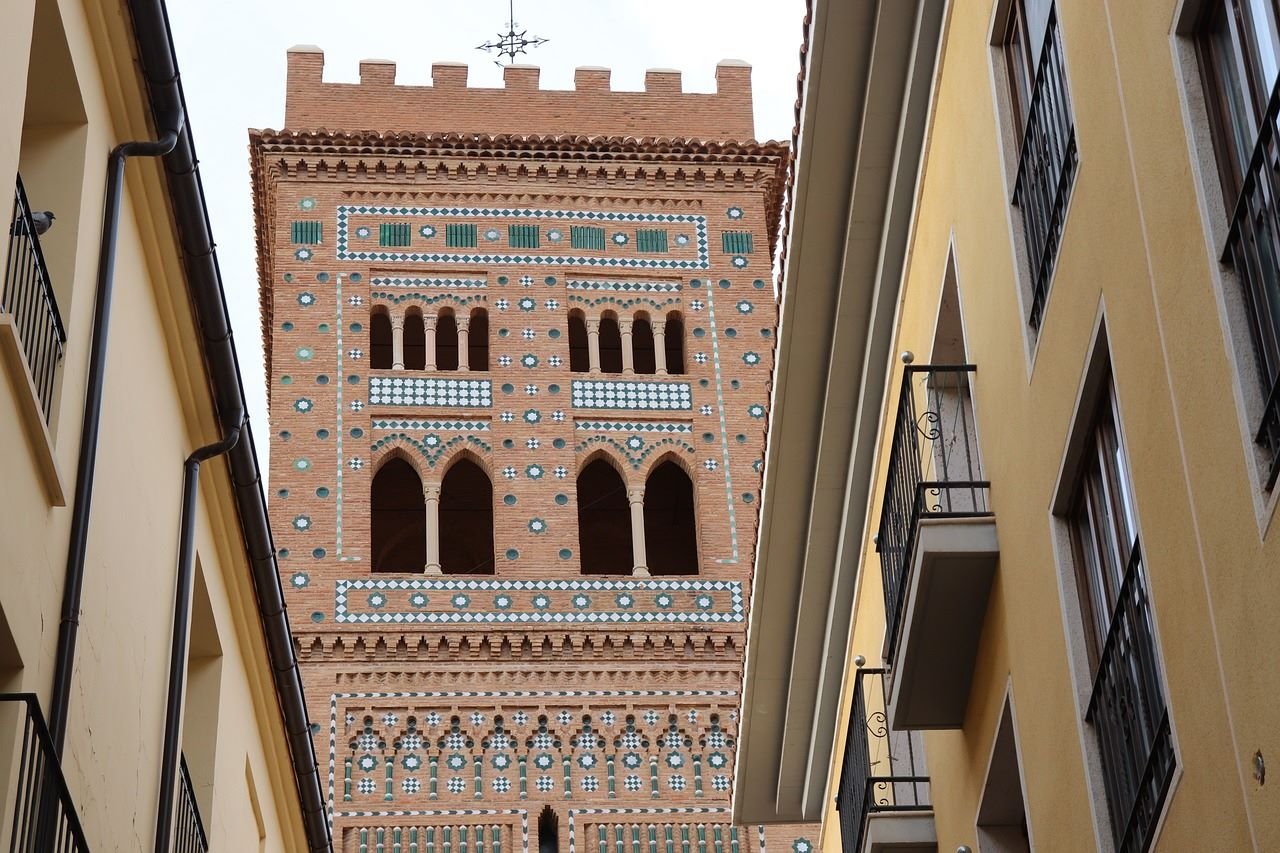
Introduction
Teruel, known as “the town of love and Mudejar,” is a hidden gem in the heart of Aragon, Spain.
Recognized as a UNESCO World Heritage site, this small but charming city offers stunning Mudejar architecture, rich medieval history, and a romantic legend that has earned it the title “City of Lovers.”
Surrounded by beautiful mountains and landscapes, Teruel provides visitors with a mix of cultural heritage, outdoor adventures, and a glimpse into authentic Spanish traditions.
1. Getting There and Around
By Train
Teruel is accessible by train from major cities like Zaragoza, Madrid, and Valencia, with the journey offering beautiful views of the Spanish countryside.
By Car
Driving is a great way to explore Teruel and the surrounding Aragon region. Roads are well-maintained, and parking is available at many points around the city.
By Bus
Regular buses operate from nearby cities, including Zaragoza and Valencia, with stops at the main terminal near the city center.
Getting Around Teruel
Teruel is compact and walkable, making it easy to explore on foot.
However, taxis are available for convenience, especially if you plan to visit nearby villages or mountainous areas.
2. Key Attractions
Plaza del Torico
This central square is the heart of Teruel’s social life, bustling with cafes and shops.
The square is famous for its statue of a small bull, “El Torico,” which is both a local symbol and a point of pride for Teruel’s residents.
Torre de El Salvador
One of the most iconic Mudejar towers in Teruel, Torre de El Salvador is a remarkable example of Islamic-influenced architecture, with intricate geometric patterns.
Climb to the top for panoramic views of the city.
Teruel Cathedral (Catedral de Santa María)
This 12th-century cathedral is another UNESCO World Heritage site and a marvel of Mudejar art, combining Gothic and Romanesque influences.
The ceiling features stunning, colorful Mudejar woodwork—a must-see for architecture enthusiasts.
The Lovers of Teruel Mausoleum
Teruel is famous for its tragic love story of Diego de Marcilla and Isabel de Segura, often referred to as “The Spanish Romeo and Juliet.”
Visit the mausoleum where their statues rest hand-in-hand, and learn more about their legend through displays and exhibitions.
Escalinata del Óvalo
This grand staircase, decorated with Mudejar tiles and reliefs, is a beautiful architectural feature that connects the city center to the train station area.
It’s also a popular photo spot with views of the city.
Acueducto de los Arcos
This impressive 16th-century aqueduct, one of the best-preserved in Spain, supplied Teruel with water for centuries.
It’s a marvel of engineering, with beautiful arches you can walk under or admire from afar.
3. Exploring Teruel’s Mudejar Art
Teruel’s Mudejar architecture is renowned worldwide, characterized by intricate brickwork, ceramic tile inlays, and geometric patterns—a blend of Islamic and Christian influences unique to Spain.
- Torre de San Martín: Another beautiful Mudejar tower worth seeing, with intricate designs and historical significance.
- Iglesia de San Pedro: This church is part of the Lovers of Teruel complex and features beautiful Mudejar details. It’s also the site where Isabel and Diego’s tragic story unfolded.
- Mudejar Walking Route: For those interested in architecture, the Mudejar Walking Route takes visitors through Teruel’s most significant Mudejar buildings, with plaques detailing their history.
4. Dinópolis: The Dinosaur Museum and Theme Park
Dinópolis is a family-friendly attraction located just outside Teruel.
It combines a museum showcasing Teruel’s rich paleontological history—this area is one of the most significant dinosaur excavation sites in Europe—with a theme park featuring dinosaur-related rides and attractions.
A perfect day out for kids and anyone interested in dinosaurs, Dinópolis offers interactive exhibits, 3D movies, and fossil displays.
5. Teruel’s Festivals and Events
La Vaquilla del Ángel (The Angel’s Heifer)
Held in July, this festival is one of Teruel’s most famous, drawing crowds for parades, dancing, and traditional bull-running events.
It’s a lively celebration of Teruel’s heritage and community spirit.
Fiestas de los Amantes (Lovers’ Festival)
In February, Teruel celebrates the Lovers of Teruel with a re-enactment of the legend, parades in medieval costumes, and traditional dancing.
The festival offers a romantic atmosphere and is a unique way to experience Teruel’s history.
Semana Santa (Holy Week)
Like many Spanish cities, Teruel observes Holy Week with solemn processions and traditional music, showcasing the city’s religious traditions and devotion.
6. Outdoor Activities
Sierra de Albarracín
A short drive from Teruel, this stunning mountain range is perfect for hiking, bird-watching, and nature photography.
It’s an excellent spot to explore the area’s diverse wildlife and beautiful scenery.
Albarracín
Considered one of Spain’s most beautiful villages, Albarracín is a medieval town located about 30 km from Teruel.
Known for its pink-hued buildings, ancient walls, and narrow winding streets, it’s an ideal day trip destination.
Cascada del Molino de San Pedro
This picturesque waterfall is located near the village of El Vallecillo and offers a serene spot for swimming and picnicking.
It’s a great place to relax and enjoy nature during warmer months.
7. Cuisine and Dining in Teruel
Teruel’s cuisine is rooted in traditional Aragonese flavors, with an emphasis on locally sourced meats, vegetables, and wines. Here are some regional specialties:
- Jamón de Teruel: The region’s famous cured ham, known for its distinctive flavor, is a must-try delicacy often served with bread and wine.
- Migas: A traditional dish made from bread crumbs, garlic, and chorizo, served with grapes or fried eggs.
- Caldereta de cordero: A hearty lamb stew with potatoes, garlic, and peppers—a perfect choice for chilly evenings.
- Ternasco: Roast lamb is a popular dish in the region and is typically served with potatoes.
- Repostería: Sample the local sweets, including “suspiros de amante” (Lover’s Sighs), a sweet pastry with a hint of lemon, and pastas de almendra (almond cookies).
Where to Eat
- Yain Restaurante: A top choice for fine dining, featuring traditional Teruel cuisine with a modern twist.
- El Mercao de Teruel: Known for its tapas and jamón, this spot is perfect for tasting a variety of local flavors.
- Asador Guadalaviar: If you’re in the mood for roast lamb or other traditional dishes, this is a great choice.
8. Shopping in Teruel
Teruel’s small boutiques and artisan shops offer unique souvenirs. Look for:
- Ceramics: Hand-painted ceramic tiles, vases, and plates are popular, many reflecting the Mudejar style.
- Jamón de Teruel: Take home a vacuum-sealed package of the region’s famous ham.
- Handcrafted Leather Goods: Leather belts, wallets, and handbags are beautifully made and available at many local shops.
For a more immersive shopping experience, visit the Mercado de Abastos for fresh produce, meats, cheeses, and other regional products.
9. Practical Information
- Language: Spanish is the primary language, and English may be limited in some areas. Basic Spanish phrases are helpful.
- Currency: Euro (€)
- Safety: Teruel is very safe, though it’s always wise to stay aware of your belongings in crowded areas.
- Best Time to Visit: Spring (April to June) and fall (September to October) offer pleasant weather and fewer crowds. However, winter brings festive events, and summer offers outdoor activities.
10. Day Trips and Excursions
- Albarracín: As previously mentioned, Albarracín is a beautiful medieval town that’s easy to reach by car or bus from Teruel.
- Sierra de Javalambre: Located to the south of Teruel, this mountain range is ideal for hiking and, in winter, skiing at the nearby ski resort.
- Ciudad Encantada (Enchanted City): Located in Cuenca, about a 2-hour drive from Teruel, this natural rock formation offers an otherworldly landscape that’s fascinating to explore.
Teruel is a place where history, romance, and traditional Spanish culture come together in a picturesque setting.
Whether you’re captivated by Mudejar architecture, intrigued by the tragic legend of the Lovers of Teruel, or drawn to the natural beauty of Aragon, this charming city promises an unforgettable experience.
With its blend of historic sites, culinary delights, and vibrant festivals, Teruel invites you to explore Spain off the beaten path.



